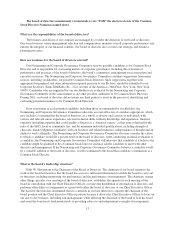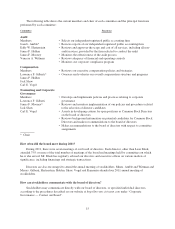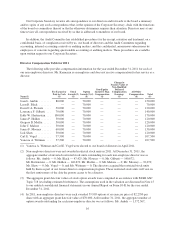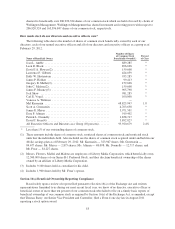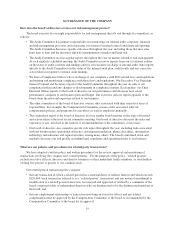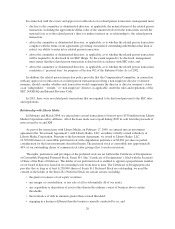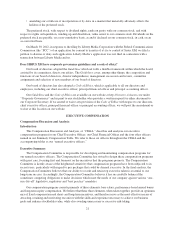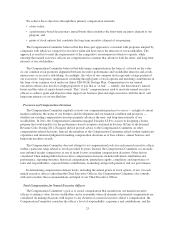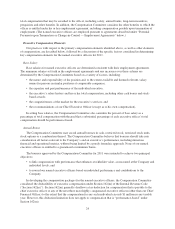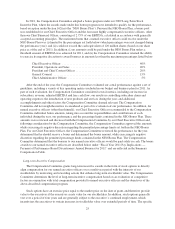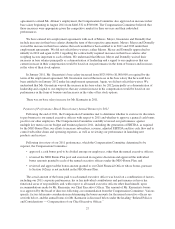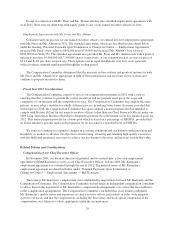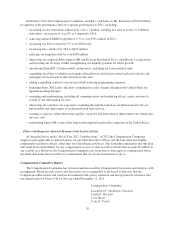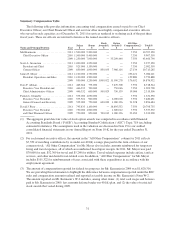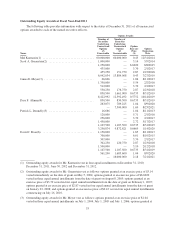XM Radio 2011 Annual Report Download - page 33
Download and view the complete annual report
Please find page 33 of the 2011 XM Radio annual report below. You can navigate through the pages in the report by either clicking on the pages listed below, or by using the keyword search tool below to find specific information within the annual report.We achieve these objectives through three primary compensation elements:
• a base salary;
• a performance-based discretionary annual bonus that constitutes the short-term incentive element of our
program; and
• grants of stock options that constitute the long-term incentive element of our program.
The Compensation Committee believes that this three-part approach is consistent with programs adopted by
companies with which we compete for executive talent and best serves the interests of our stockholders. The
approach is an effort to meet the requirements of the competitive environment in which we operate, while
ensuring that named executive officers are compensated in a manner that advances both the short- and long-term
interests of our stockholders.
The Compensation Committee believes that delivering compensation in the form of, or based on the value
of, our common stock promotes alignment between executive performance and stockholder interests and avoids
unnecessary or excessive risk-taking. Accordingly, the value of our common stock represents a large portion of
our executives’ long-term compensation, including through grants of stock options and matching contributions in
the form of our common stock under our Sirius XM 401(k) Savings Plan. Compensation for our named
executives officers also involves a high proportion of pay that is “at risk” — namely, the discretionary annual
bonus and the value of equity-based awards. This “at risk” compensation is used to motivate named executive
officers to achieve goals and objectives that support our business plan and align executives with the short- and
long-term interests of our stockholders.
Processes and Compensation Decisions
The Compensation Committee regularly reviews our compensation practices to assess — in light of current
market conditions, the status of our business and development and our financial condition and prospects —
whether our existing compensation structure properly advances the near- and long-term interests of our
stockholders. In 2011, the Compensation Committee engaged Exequity LLP to assist it in designing a bonus
program that would qualify for the performance-based exception contained in Section 162(m) of the Internal
Revenue Code. During 2011, Exequity did not provide advice to the Compensation Committee on other
compensation-related decisions. Instead, the members of the Compensation Committee relied on their significant
experience and informed judgment in making compensation decisions as to base salaries, annual bonuses and
long-term incentive awards.
The Compensation Committee does not attempt to set compensation levels for each named executive officer
within a particular range related to levels provided by peers. Instead, the Compensation Committee occasionally
uses informal market comparisons as one of many factors in making compensation decisions. Other factors
considered when making individual executive compensation decisions include individual contribution and
performance, reporting structure, historical compensation, internal pay equity, complexity and importance of
roles and responsibilities, expected future contributions, leadership and growth potential, and our performance.
In determining compensation element levels, including the annual grants of stock options, if any, for each
named executive officer (other than the Chief Executive Officer), the Compensation Committee also consults
with and considers the recommendations and input of our Chief Executive Officer.
Total Compensation for Named Executive Officers
The Compensation Committee’s goal is to award compensation that incentivizes our named executive
officers to enhance value for our stockholders and is reasonable when all elements of potential compensation are
considered. In making decisions with respect to any element of a named executive officer’s compensation, the
Compensation Committee considers the officer’s level of responsibility, experience and contributions, and the
23


